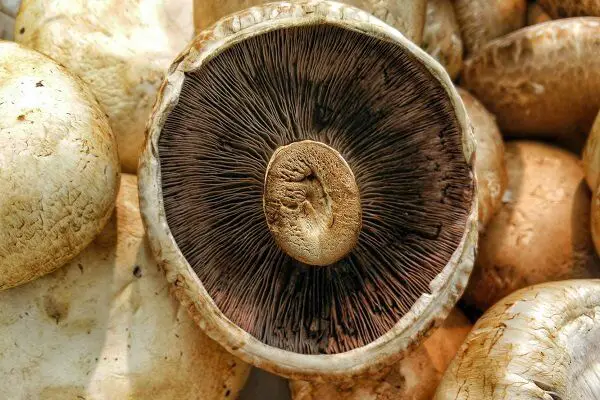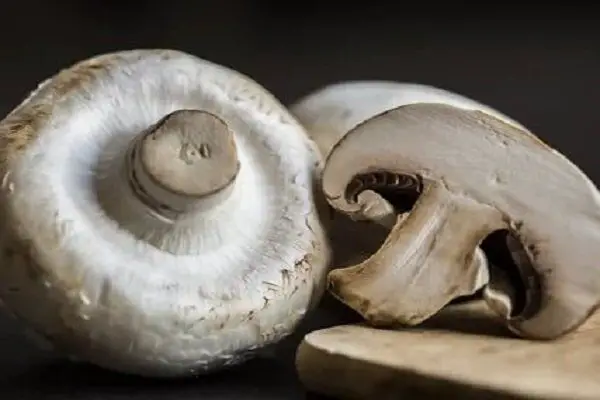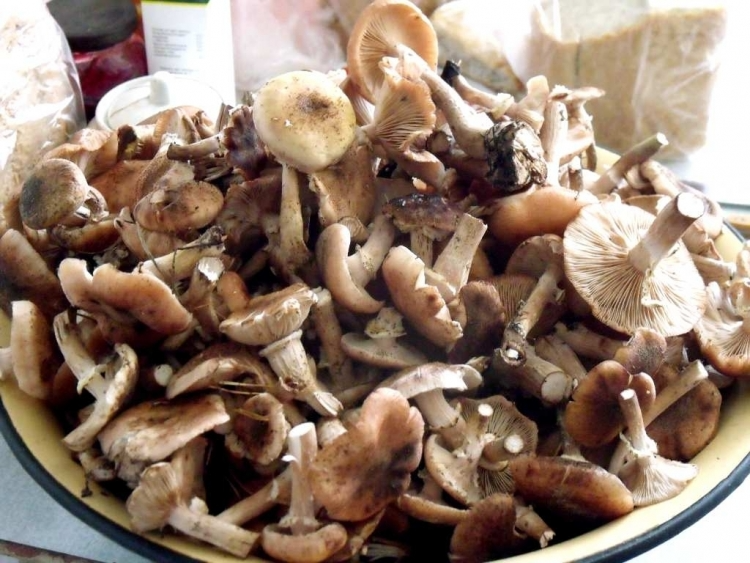Black mushrooms aren’t a distinct variety; rather, they undergo color changes due to various reactions, such as spores interacting with different substances like oxygen. These color alterations can occur in fresh, dried, or even canned mushrooms. This arises the question: what causes Mushroom Turned Black, and How to Prevent Mushrooms From Turning black?
Understanding the reasons behind a mushroom turning black is crucial for determining its edibility.

Mushroom Turned Black: what to do if mushroom turns black inside
Table of Contents
Why Do Mushrooms Turn Black?
Determining the reason behind the darkening of naturally white mushrooms is feasible. This can be done by observing key features such as the location of the blackness and the presence or absence of other accompanying changes. Additionally, the circumstances surrounding the color change, such as cooking, frying, or defrosting, play a significant role.
When a mushroom becomes black, it could be due to various factors such as oxidation, cooking, or improper storage.
Let discuss every reason why Mushroom turn black? and What happens if mushrooms turn black?
Mushroom black under cap
If the area beneath the mushroom cap darkens, there’s generally no cause for concern; it often signifies the full ripeness of the mushroom. However, exceptions exist.
If the blackness extends throughout the entire spore-bearing layer without any lighter patches, the mushroom may be toxic, especially in the case of forest mushrooms.
Mushrooms picked prematurely may darken over time, particularly if they’ve been stored for a prolonged period on store shelves or in a refrigerator.
Mushrooms turned black inside
When mushroom turned black inside, the cause is typically oxidation due to exposure to air, specifically oxygen.
To determine if such mushrooms are safe to eat, certain signs should be observed by cutting them with a knife:
- Body elasticity.
- Presence of numerous white areas amidst the black mass.

If, upon cutting If mushrooms are black inside entirely, it indicates the accumulation of toxic substances, rendering it inedible.
Additional indications of inedibility include:
- Foul odor.
- Presence of mold.
- High humidity.
Mushrooms turn black when cooked
When Mushrooms turn black when cooked or heated, it’s due to the carbon content within the fruiting bodies. Exposure to high temperatures makes this darkening, which is typically considered a normal and acceptable reaction, as long as they remain white before cooking.
Mushroom getting black after defrosting
If mushrooms turn black after defrosting, it’s often a result of improper storage techniques.
While freezing is a common method for long-term storage, if mushrooms are placed in plastic containers or bags without proper sealing, physiological disturbances can occur in the spores, leading to blackening upon thawing. Vacuum packaging is preferable as it prevents such issues by excluding oxygen.
Consuming blackened thawed mushrooms isn’t necessarily harmful, provided the following signs are absent:
- Mushrooms exuding sticky mucus.
- Development of an unusual odor.
- Excessive darkening of the spore-bearing lamellar layer.
- Noticeable signs of decay.
- Presence of large black spots covering the cap.
Can we eat mushrooms if it turns black?
Yes, it is possible to eat mushrooms that have turned black or mushroom inside black, but it’s important to consider the specific circumstances and take necessary precautions.

Here are guidelines for different situations when is black part of mushroom edible:
- Black Plates (Black part of mushroom): Examine the extent of darkening of the lamellar layer. If it’s completely black with the presence of mucus, there’s a risk of poisoning. Slightly darkened mushrooms with fully opened caps can be eaten, but ensure they are boiled for 40-45 minutes before frying.
- Dark Flesh and Skin: If both the plates and the flesh have turned black, assess the level of darkening visually. If it’s minimal and there are no unusual odors, excessive mucus, or foreign substances, the mushrooms can be eaten after thorough heat treatment.
- Raw Darkened Mushrooms: While raw champignons are typically safe to eat and nutritious, darkened specimens are not recommended raw due to potential pathological processes caused by pathogens. Boiling or frying destroys bacteria and makes the mushrooms safe to consume.
cooking slightly blackened champignons
When cooking slightly blackened champignons, ensure they are cooked for at least 10-15 minutes, preferably 40-50 minutes, depending on the degree of darkening.
In case of poisoning, immediate first aid should be administered:
- Rinse the stomach by drinking 1.5-2 liters of clean water (preferably boiled) and inducing vomiting by pressing the root of the tongue with a finger(repeat up to 3 times).
- Take a sorbent like activated charcoal (1 tablet per 10 kg of body weight).
- After these steps, consume 200-300 ml of weakly brewed black tea, dried fruit compote, or rosehip decoction without sugar.
How to Prevent Mushrooms From Turning black?

To ensure mushrooms stay fresh and avoid discoloration, it’s crucial not to wash them after harvesting or purchasing. The delicate spore-bearing layer readily absorbs water, causing the mushrooms to darken.
Here are some methods and conditions for processing and preserving mushrooms:
mushroom Processing Methods and Shelf Life:
The shelf life of mushrooms depends on the processing method and condition:
- Fresh mushrooms at room temperature: 12 to 18 hours.
- Refrigerated (stored on the vegetable shelf): 3 to 6 days.
- Raw frozen: 6 to 9 months.
- Boiled and frozen: up to 6 months.
- Dried: 12 to 18 months.
- Home-canned: maximum of 6 months.
- Factory-pickled: up to 12 months (due to preservatives).
mushrooms Storage Conditions and Methods:
There are rules on the conditions and methods of storing mushrooms:
- Avoid purchasing mushrooms that have been on display for more than 72 hours.
- Store mushrooms in a tightly sealed container or vacuum bag to minimize oxygen exposure (this also prevents drying).
- Ideal refrigerator temperature: +5–7°C, preferable from 0 to +2°C.
- Change packaging every 2–3 days to prevent condensation buildup.
- Fresh mushrooms stored without containers tend to dry out quickly.
- Fresh, boiled, or fried mushrooms can be kept in the freezer (unwashed fresh ones, cleaned of dirt; fried ones placed on paper towels to remove excess fat).
- Ensure freezer temperature remains below -18°C.
dried mushrooms
An excellent storage option is dried mushrooms. There are two ways to dry mushrooms:
- Cut mushrooms thinly or into cubes, place on a baking sheet, and dry in the oven at +45–50°C until moisture evaporates completely.
- Thread sliced or whole mushrooms onto a string and hang them in direct sunlight. Bring indoors at night. When mushrooms become brittle, they are ready.
It is convenient to grind dry semi-finished products and store them in powder form (for sauces, soups).
how to keep mushrooms fresh longer?
When seeking to preserve the freshness of raw mushrooms for consumption, especially in dietary regimens, several methods prove effective:
- Prepare a saline solution in a saucepan (using 2–3 tablespoons of salt per liter of water). Boil the mushrooms for 2–3 minutes after the solution reaches a boil, then remove, drain excess water, and freeze.
- Store unwashed mushrooms in a plastic container in the refrigerator, covering them with a natural cloth towel to maintain dryness.
- Portion mushrooms into canvas bags, then store these in a sealed container.
Before carrying out manipulations to extend freshness, you need to properly prepare mushrooms for storage:
- Trim the edges of the stems with a sharp knife, avoiding tearing.
- Gently brush away any dirt or soil.
- Discard any damaged or broken parts.
- Wipe the mushrooms with a soft, dry cloth to remove surface moisture.
But, even if all the conditions and requirements are met, it is unacceptable to keep mushrooms in the refrigerator for more than 7 days. After the expiration of the period, toxic substances begin to be produced in them.
how to pick fresh mushrooms?
Ideally fresh Mushroom has a presentable appearance: smooth, without damage and breaks. Other signs of a really high-quality mushroom picking is:
- Smooth appearance without damage or breaks.
- Matte cap shade.
- White or white-pink body color.
- Slightly velvety or smooth surface.
- Intact film between cap and stem.
- Leg cut darkening but not blackening.
- Pleasant mushroom aroma.
- Firm and elastic texture when pressed.
Even if mushrooms have minor external imperfections from transportation, they can still be consumed safely.
Conclusion
Not all black mushrooms can be eaten. It is only important to learn how to distinguish mushrooms that simply darkened for natural reasons from a mushroom turned black is spoiled. But, even if there is complete confidence in the fit state of mushroom, it is not recommended to eat them without prior thermal treatment.